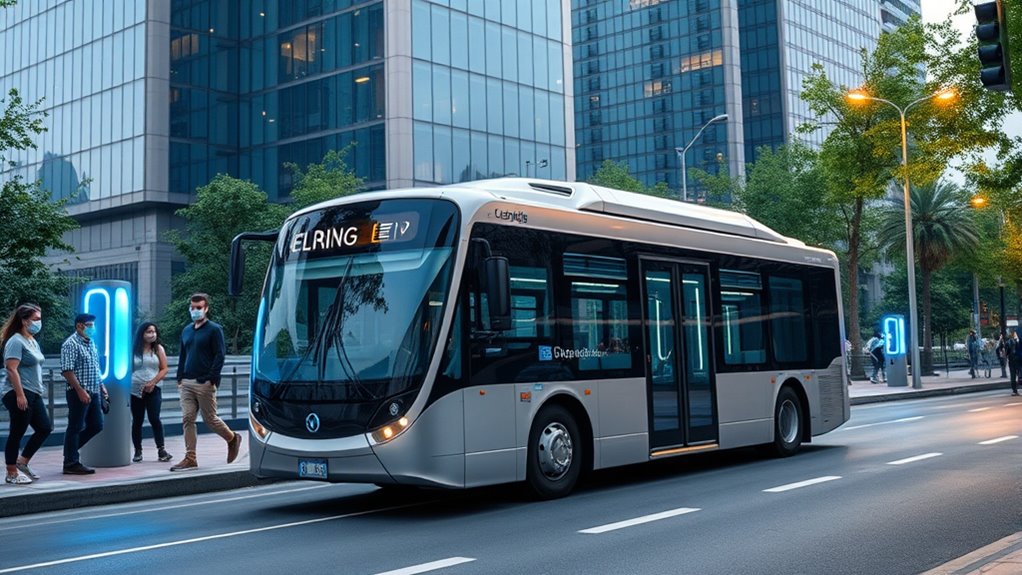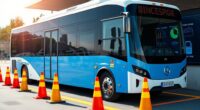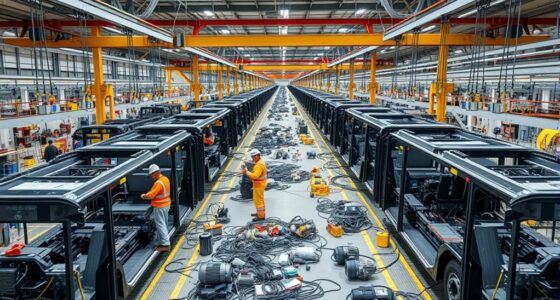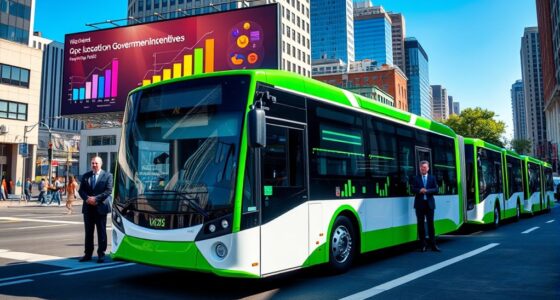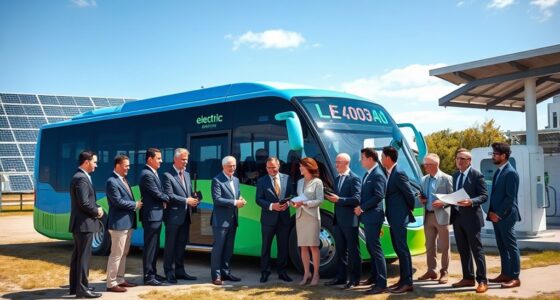The pandemic pushed you to rethink transportation options, making electric buses more appealing. With transit agencies facing financial cuts and ridership plunging, they looked for ways to cut long-term costs and improve air quality. Governments added electric buses to their green recovery plans, boosting investments despite disruptions. This shift was fueled by environmental concerns, lower maintenance costs, and policies supporting electric vehicle adoption. To explore how this momentum gained traction worldwide, keep exploring.
Key Takeaways
- Reduced transit ridership during the pandemic highlighted financial strains, prompting agencies to adopt cost-saving electric bus technologies.
- Environmental benefits from decreased emissions increased support for electric buses as part of green recovery plans.
- Governments accelerated policies and funding commitments to switch to zero-emission buses amid economic recovery efforts.
- Transit agencies prioritized electric bus procurement to reduce operational costs and dependence on volatile fuel markets.
- The pandemic spurred technological innovation and infrastructure development, boosting electric bus adoption worldwide.

The COVID-19 pandemic drastically reduced public transit ridership worldwide, leading to significant revenue losses that delayed investments in electric buses and infrastructure. When ridership plummeted—U.S. public transit dropped 80% in April 2020, and global figures remained over 60% below pre-pandemic levels—it became clear that transit agencies faced severe financial constraints. These losses temporarily paused plans for procuring new electric buses and expanding necessary charging infrastructure.
However, the crisis also shifted priorities, making modernization efforts more urgent to address environmental concerns and operational costs. As cities and governments looked for ways to recover, focus shifted toward clean transportation solutions. The pandemic made air quality improvements from reduced transportation emissions more visible, prompting governments to integrate electric buses into their green recovery strategies. Many countries included e-buses in stimulus packages, recognizing their potential to create jobs and support climate goals.
The pandemic accelerated focus on clean transport, integrating electric buses into green recovery and climate strategies worldwide.
The economic benefits of electric buses, especially lower maintenance costs due to fewer moving parts, became more attractive as transit agencies faced tight budgets. Simultaneously, the development of autonomous electric buses accelerated, with transit agencies enthusiastic to innovate and reduce long-term operational costs.
Post-pandemic, adoption disparities emerged across regions. China maintained its dominance, with 97% of the global e-bus fleet as of 2021. European countries like Belgium and Norway surpassed 50% of e-bus sales by 2023, while Latin American cities deployed around 6,500 e-buses by that year, led by Bogotá and Santiago.
In the United States, commitments to electric school buses surged—by October 2024, over 12,000 had been ordered across 48 states, with New Hampshire experiencing a remarkable 1,000% growth in school e-bus commitments, jumping from 7 to 117 buses.
Regulatory frameworks also supported this shift. Seven U.S. states enacted mandates requiring zero-emission school buses by 2024, covering 100,000 buses—about 19% of the national fleet—and six million riders. California, New York, and Washington implemented binding timelines for fleet electrification, while European cities introduced low-emission zones favoring electric buses. Chile launched national strategies with measurable targets to deploy e-buses, further accelerating adoption.
Economic and environmental drivers pushed the transition forward. Electric buses reduce dependence on volatile fuel markets, and their lower operational and maintenance costs offer long-term savings. Transportation contributes nearly 30% of global greenhouse gas emissions, and electrification can cut operational costs by 30-50%. Additionally, the integration of infrastructure development such as charging networks and advanced battery technologies has been crucial in supporting fleet expansion. This focus on sustainable transportation aligns with global efforts to combat climate change. Moreover, public awareness about climate impacts has increased stakeholder support for electric vehicle adoption, accelerating policy and investment commitments.
Furthermore, regional policy initiatives have created a conducive environment for electric bus adoption, emphasizing the importance of supportive regulations and incentives.
Frequently Asked Questions
How Do Electric Buses Impact Urban Air Quality Long-Term?
Electric buses improve urban air quality long-term by eliminating diesel exhaust emissions, which reduces particulate matter and ground-level ozone precursors. You’ll notice cleaner air, fewer health risks like respiratory issues, and lower urban heat.
Their zero tailpipe emissions prevent pollution hotspots, and as fleets scale up, the cumulative health benefits grow. Plus, the shift to electric supports broader decarbonization goals, making your city healthier and more sustainable over time.
What Are the Main Challenges in Electric Bus Infrastructure Deployment?
Imagine trying to set up electric bus charging stations in a busy city with limited space. That’s a key challenge you face: high initial costs for infrastructure, space constraints, and ensuring your power grid can handle the increased demand.
Managing charging schedules, training staff, and integrating new tech also complicate deployment. You need strategic planning and investment to overcome these obstacles and expand your electric bus network effectively.
How Do Electric Buses Compare Cost-Wise to Traditional Diesel Buses?
You’ll find electric buses cost about 50% more upfront than diesel models, with prices around $887,308 for a 40-foot bus. However, they save you money over time through lower fuel costs—about 2.5 times cheaper—and reduced maintenance.
Over a 12-year lifespan, you can save between $73,000 and $173,000. Plus, incentives and stable electricity prices make them a more cost-effective choice long-term.
What Innovations Are Emerging for Faster Electric Bus Charging?
You’re exploring innovations for faster electric bus charging. Currently, advanced conductive systems like roof-mounted and inverted pantographs allow rapid top-ups, while split-system charging offers flexible energy management.
Wireless inductive charging eliminates contact points, enabling quick stops, and autonomous robotic connectors streamline depot charging. Additionally, under-road embedded systems and AI-driven energy management optimize on-route recharging, reducing downtime.
These breakthroughs collectively aim to make electric bus charging faster, more efficient, and seamlessly integrated into transit operations.
How Has Public Perception Shifted Towards Electric Buses During the Pandemic?
You might think public perception stayed the same during the pandemic, but it actually shifted considerably. As media highlighted electric buses’ environmental and health benefits, you likely became more supportive of cleaner transportation.
Increased awareness of air pollution’s health impacts made electric buses more appealing. Governments and private sectors also worked to promote their advantages, making you more inclined to see electric buses as a crucial part of sustainable urban transport.
Conclusion
The pandemic pushed you to see electric buses as a vital solution, with global orders increasing by over 300% in just two years. Imagine fleets replacing thousands of diesel buses, reducing emissions and improving air quality in your city. This rapid shift shows how crises can accelerate innovation and change. As you witness cleaner, quieter streets, remember how the pandemic’s challenges helped fuel a greener future, making electric buses a crucial part of your community’s journey forward.
